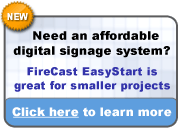Digital: Online Ads Not Working for You? Blame the Creative - Advertising Age - Digital
Something we've harped on for a long time over at WireSpring is the need for great content on your digital signage systems. Too often, people blame their network failures (and there have been many of these over the years) on cost management, technology problems, unwilling advertisers and dozens of other things, when in reality the real problem was that their content wasn't compelling, and consequently their network wasn't achieving its goals.
We're not alone in this problem, as the above-linked AdAge article explains:
It's bad creative that makes online advertising ineffective, so stop obsessing over targeting and placements, according to a study from online-ad-research group Dynamic Logic. After analyzing the highest and lowest performers from its database of more than 170,000 online ads, the Millward Brown company determined that creative factors such as persistent branding, strong calls to action and even human faces -- and not super-targeted or high-profile ad placements -- make for better ad recall, brand awareness and purchase intent.
Simply put, an ad is only as strong as its weakest links, and according to the Dynamic Logic study, that weakest link is frequently the quality of the creative itself. Not planning, not placement, not measurement, but content.
Digital signage content producers and ad network owners need to keep this in mind when deciding how to apportion their budgets. Don't leave enough in for good creative, and you might be deploying a very expensive, very failure-prone network.
 The first comes from The Consumerist, where reader Grey was confronted (and affronted) by a shelf-edge signage system for Bumblebee Tuna:
The first comes from The Consumerist, where reader Grey was confronted (and affronted) by a shelf-edge signage system for Bumblebee Tuna: The inanity of the Bumblebee display must have primed my brain because when I ran into this article at Advertising Lab it seemed like it might as well have come from the same company. Straight out of the what-were-they-thinking department of RightGuard's R&D lab comes this inspired idea to put digital advertising not where one might purchase the product, but where one might actually use the product. That's right, we're talking about armpit advertising! Awful puns aside (and there are lots of them), there's really not much else I can say about this. In fact, I think the expression of the woman on the left pretty much says it all...
The inanity of the Bumblebee display must have primed my brain because when I ran into this article at Advertising Lab it seemed like it might as well have come from the same company. Straight out of the what-were-they-thinking department of RightGuard's R&D lab comes this inspired idea to put digital advertising not where one might purchase the product, but where one might actually use the product. That's right, we're talking about armpit advertising! Awful puns aside (and there are lots of them), there's really not much else I can say about this. In fact, I think the expression of the woman on the left pretty much says it all...





 Subscribe to this blog
Subscribe to this blog Follow Bill Gerba on Twitter
Follow Bill Gerba on Twitter